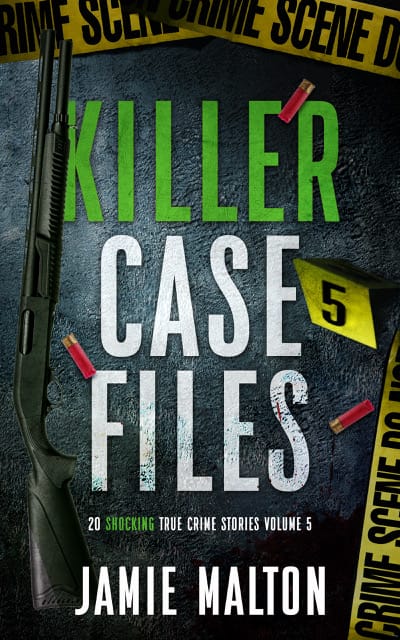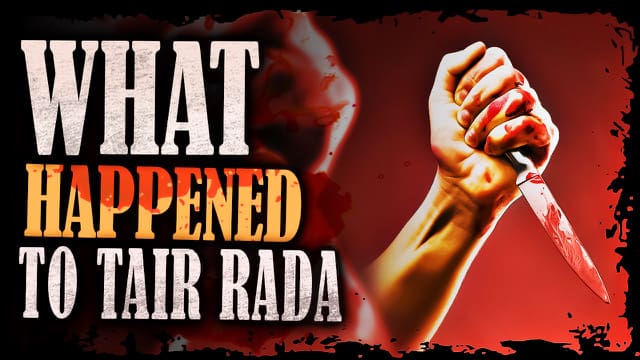
KILLER CASE FILES – VOLUME 5
BONUS CHAPTER

Thanks for being one of my readers!
Jamie
What Happened to Tair Rada
“Of the 18 samples analyzed, one was found to possibly contain the DNA of a man named Adir Habani and not defendant Zadorov, who has always maintained his innocence. The other 17 samples matched the DNA of the victim.”
– The Times of Israel
Often called Israel’s Twin Peaks, the murder of Tair Rada still dominates the headlines in this country. More than 15 years have passed since her lifeless body was discovered in the school. Yet it seems like the real killer has managed to avoid justice all this time.
Background
Tair Rada was born on January 4, 1993. She was the youngest child of Ilana and Shmuel. Her two older brothers, Roy and Ohad, adored their little sister. The Rada family lived in Katzrin, a quiet town in northern Israel surrounded by stunning nature. Tair attended the Nofey Golan High School and was one of the popular girls in her class.
She was exceptionally good at dance and enjoyed music and theater too. She had a tight knit group of friends who regularly spent time together. Almost all children walked home after school since Katzrin is considered a low-crime place. But Tair always made sure to call her mother as soon as she stepped inside the house.
The Search
Wednesday, December 6, 2006, started as a typical day for 13 year old Tair. She skipped her last period class because her friends were hanging out in front of the school. Around 01:00 PM, Tair said she was thirsty, so she went inside the school to drink some water. A couple of students confirmed they saw her climb the stairs toward the restrooms on the mid-floor. She didn’t return, and her friends thought Tair went home without them.
Meanwhile, Tair’s mother, Ilana, was expecting a call from her daughter. She assumed the teen stopped at a friend’s house or fell asleep in her room after school.
But when Ilana came home she noticed that Tair’s backpack wasn’t in its usual place. There was no sign she was home after school. Ilana was worried, so she dialed Tair’s cell phone – there was no answer. She then called Tair’s friends, who said they didn’t see her after 01:00 PM. Sensing something was wrong, Ilana asked Shmuel, Roy, and Ohad to come home.
The authorities were called, and Shmuel checked Tair’s usual route home. The police and family organized a small search to look for her. More neighbors and friends joined in and groups of them started combing the nearby area. The night was approaching quickly and temperatures could be low, especially in December.
Around 07:00 PM, one group decided to check the school since that was the last known location of the missing teen. The classrooms were empty, but they noticed one stall was closed in the bathroom on the mid-floor. Unable to get inside, one person peeked through the crack and saw someone inside. The figure was silent, so they used the stall next to it to see what was going on.
What they saw was horrifying. Tair was slumped over the toilet with multiple stab wounds and a slashed throat. The stall was covered in blood, and the crime scene looked like something out of a horror movie. Tair’s parents were notified that the girl was found but that she was unconscious. Shmuel arrived at Tair’s school and found out she was dead.
The Investigation
The community outrage forced the authorities to investigate this crime as quickly as possible. Panic was taking over the town of Katzrin and parents refused to allow their children to go out. Someone killed a teen girl in the middle of the day in a crowded school building.
Classes were canceled for the next few days since the police needed to process the crime scene. But instead of focusing on the high school, the investigators moved further away to Golan Heights and Galilee, which confused both Tair’s family and the public.
The interviews with Tair’s classmates uncovered some useful details about what happened on the day of the murder. A couple of students who knew the teen said she was on her way to the bathroom at 01:20 PM. She was alone and nobody was following her. Then a group of female students confirmed they went to the same bathroom after 01:20 PM and didn’t notice anything suspicious. One girl mentioned she saw Tair’s sneakers and a second pair of shoes inside the stall. Tair’s friend knocked on the stall door, and a female voice replied that it was occupied.
Soon, rumors started circulating among the students. It was nearly impossible for investigators to separate fact from fiction. One student mentioned bumping into an unknown girl inside the bathroom but thought she was a new student. The girl was never seen again after the murder. The police couldn’t verify this sighting and several others, so they simply stopped interviewing the students.
Ilana, Tair’s mother, was convinced that one of her peers was the killer, and a private investigator Haim Sadovsky who offered his services to the grieving family, confirmed this theory. He took a closer look at the girls from Tair’s class and detected several inconsistencies in their stories.
After examining Tair’s injuries and the crime scene, Sadovsky concluded the girl wasn’t murdered by an adult person. Instead, his theory was that two persons, approximately the same height and build as Tair, killed the teen.
However, law enforcement decided to check the testimony given by the school psychologist. The psychologist saw the school gardener on the day of the murder, and he looked visibly shaken. The gardener was taken into custody, but soon the police revealed he had a solid alibi.
Unable to let go of this line of inquiry, the investigators searched for anyone who fit the description of the gardener. That led them to the maintenance man who was at the school on December 6. His name was Roman Zadorov.
Who is Roman Zadorov
Roman Zadorov moved to Israel from Ukraine in 2004. His then-girlfriend relocated to Israel with her family. The couple soon married and had a son in November 2006. Zadorov’s visa didn’t allow him to work legally in Israel. So he had to work for contractors who paid him in cash. Zadorov’s wife encouraged him to apply for citizenship, which he did. With no previous arrests, becoming a permanent resident of Israel seemed achievable.
In 2006, Zadorov was working on refurbishing the Nofey Gola High School. He was taken into custody on December 11. After denying he had anything to do with the murder, he could not provide the investigators with the clothes he wore on the day in question. According to Zadorov, he threw everything out.
While the suspect was in the police station, police officers searched his house for potential evidence. They discovered Zadorov was a knife collector, which they found interesting because a knife was the murder weapon.
Convinced they had their guy, the police threatened Zadorov with the DNA evidence collected from the scene. The investigators lied to Zadorov by telling him his DNA was discovered in the bathroom stall. They hoped that would be enough to make him confess. Zadorov was confused and continued saying he was innocent.
Using fake evidence is not uncommon, and Zadorov asked openly if the investigators were lying to him. They said no. Zadorov was allowed to rest after a long day of interrogation, so he was sent to a jail cell. There he met a man who was an informant paid to get a confession out of Zadorov. They talked for more than a week, and seeing that Zadorov wasn’t going to say he murdered the girl, he came up with yet another lie.
The informant helped Zadorov come up with a story. On December 19, the police announced that Roman Zadorov confessed to the murder of Tair Rada. One day later, Zadorov’s attorneys, Gail and David Spiegel, said the confession was coerced, and that the details didn’t match the evidence. But that didn’t matter to the police.
Allegedly, the Zadorov’s motive was simply Tair’s rude behavior. The investigators stated that Tair asked Zadorov for a cigarette, and when he refused to give her one, the teen insulted him. Yet Tair’s family said the girl didn’t smoke and couldn’t stand the smell of cigarettes. Furthermore, they never heard her cuss at anyone.
The Trial
The trial began on July 2, 2007. Gail and David Spiegel firmly believed their client was innocent. There were no DNA traces of Zadorov inside the small bathroom stall, and the search of his house didn’t give the investigators any physical evidence that could place him there.
The attorneys even discovered that Zadorov had an alibi for the period after 01:00 PM. He talked to his employer at 1:30 PM, the estimated time of Tair’s death. Several employees saw him outside near the school gates. Later he went to the school basement and came home after 5:00 PM.
The prosecution relied on the reenactment video that contained numerous elements of false information and a bloody footprint discovered on Tair. But the investigation found no trace of blood inside Zadorov’s household or on his shoes.
Nevertheless, in September 2010, Roman Zadorov was sentenced to life in prison.
The Reopening of the Case
Even though Tair’s mother Ilana tried to accept the results of the police investigation, she expressed her doubt openly in the years after the trial. Zadorov’s lawyers also continued to fight for his innocence and filed several appeals. All were rejected.
While the Israeli public was familiar with the case, it became well-known internationally after the release of the documentary Shadow of Truth in 2016. It was the most-watched true crime series on Netflix at one point.
The documentary introduced an alternative version of the events, which includes a man named Adir Habani and his ex-girlfriend Ola Kravchenko. Habani, who was 28 at the time, spoke to the investigators back in 2012 and told them Kravchenko murdered Tair Rada.
But why was Habani even talking to the police? He was being questioned after Ola Kravchenko had accused him of sexual assault and harassment. During the interrogation he told the police what Kravchenko had done.
According to him, Kravchenko disguised herself as a man on the day of the murder and ambushed Tair in the school bathroom. She was wearing Habani’s clothes, a wig, and a chest binder.
The police took this version of the events with a grain of salt because they knew Kravchenko and Habani had a very abusive and toxic relationship that lasted ten years. He had even released her nude photos online as an act of revenge.
The investigators concluded Habani was lying in an attempt to get even with Kravchenko for breaking up with him. However, the previously mentioned documentary Shadow of Truth painted her as a possible killer, and Kravchenko experienced bullying in the months and years after the release of the documentary.
Meanwhile, Zadorov’s legal defense discovered that the hair found on Tair’s lifeless body wasn’t tested for DNA. Law enforcement stopped the forensic examination because they were sure Zadorov was the killer. In 2018, the hairs found on the teen girl were finally examined, and the mitochondrial DNA matched Adir Habani.
In June 2020, Zadorov’s appeal was accepted, and the retrial began. He was placed under house arrest in 2021, but his testimony changed several times during the new trial which made doubts linger as to whether he was telling the whole truth or not.
The murder of Tair Rada continues to be covered in the media in Israel. Hopefully advancements in DNA testing will soon finally tell us what really happened to young Tair on that December day back in 2006.






